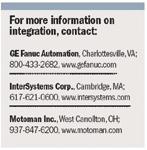Last month, I defined integration as the blending of data, applications, and processes into a functioning, unified whole. While some may view this concept as just another fad or a new buzzword, it's not. It's part of the continuum of digital communications that began with networks, fieldbuses, and open communication standards. Integration is the newest addition to a progression of technologies leading to ubiquitous, real-time data; greater efficiency; and a clearer view of operations and processes.
 Tom Kevan |
Why should you care? Because making the most of your data allows you not only to survive but to succeed in a world that increasingly demands greater operational agility and efficiency. These values are relevant whether you're in a boardroom or on an assembly line.
A number of tangible benefits make integration everybody's business. First, by using integration products, companies can gain a real-time view of all of their data and operations and create an infrastructure that ensures that software applications can exchange and update critical data wherever they reside.
"It's about the bigger picture," says Tony DaSilva, director of operations for Motoman Inc., a company that has installed more than 22,500 robots and delivered automation solutions in a wide range of applications and industries. "You can have a sophisticated piece of equipment that works perfectly fine as an island of automation, but you get more value out of that piece of equipment if it can integrate well with the remainder of the manufacturing operations, as far as letting manufacturing personnel and management that are responsible for the overall process know how each piece of equipment is performing—being able to monitor on a real-time basis."
Integration also fosters modularity and extensibility, enabling you to maximize your existing IT investments and get greater functionality. In a recent conversation, Trevor Matz, managing director of Ensemble for InterSystems Corp., a provider of integration platforms, observed, "Integration unlocks information and functionality in individual applications and turns them into a shared, company-wide resource."
 For more information on integration, contact |
Integration lets you convert individual software applications into a resource that can be used by other, interconnected applications and processes. Creating composite applications combines new code, interfaces, and processes with legacy software allowing you to rapidly deploy new applications and leverage existing application functionality in new ways.
In addition, by integrating data and applications, the systems' functionality becomes more robust than that of a series of isolated automation systems.
"Generally, the feature set is going to be more robust if you have a tightly integrated solution, rather than an interoperable solution," says Jack Wilkins, Proficy product manager for GE Fanuc. "Interoperable is where I have Thermocouple A and Communications Technology B, and all they get out of it is the temperature. But if you have tight integration, you have Thermocouple A and Integration Technology B, which provides the temperature, the basic requirement, and a trend chart, showing the drift over time of that thermocouple, the deviation of the calibration of the thermocouple, and other pertinent data about the thermocouple. You have much tighter integration now among the thermocouple, the technology, and what the customer is looking for at the back end."
Cost savings are another benefit. Optimizing and streamlining processes and operations increases overall efficiency and reduces costs. By leveraging the data and functionality of your legacy systems, you obviate the replacement of existing infrastructure. Integration solutions reside on top of existing software applications; they don't replace them.
Finally, data and process integration let your operations and company become more agile and responsive. With these new tools and techniques, you can design your systems to dynamically adapt to changing conditions as identified by a more complete picture of operations and processes through real-time data.
Tom Kevan is a freelance writer/editor specializing in information technology and communications.